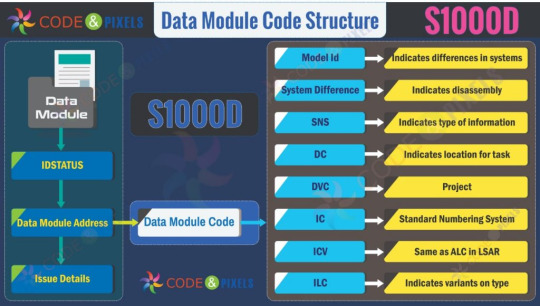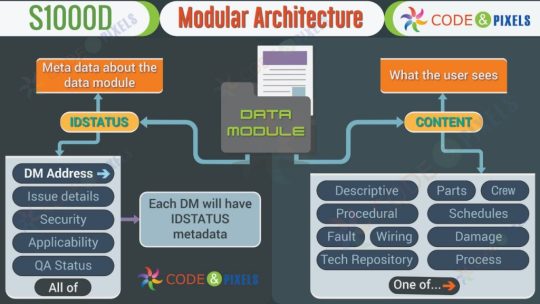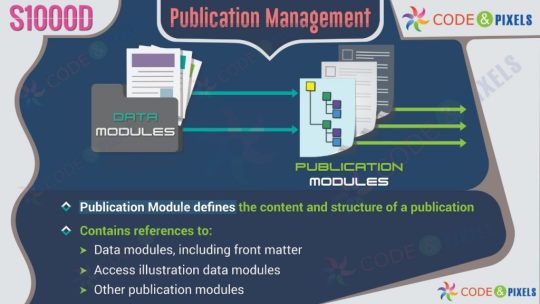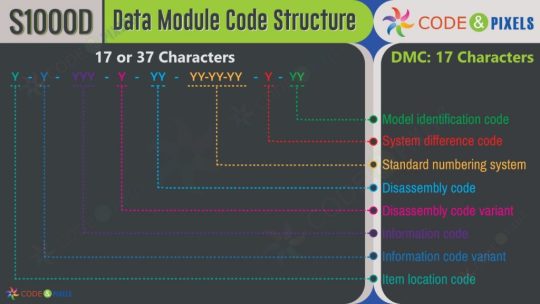#s1000d code structure
Explore tagged Tumblr posts
Text
What is S1000D | Code And Pixels
The S1000D specification requires a document to be broken down into individual data items (called Data Modules) which can be marked with individual XML labels and metadata, and be part of a hierarchical XML structure. This permits the updating of single data items without necessarily changing the path down the XML tree which points to them.
#s1000d#s1000dbenefitsofxml#s1000ddatamodulecode#s1000dietm#s1000dinfographics#s1000dsoftware#s1000dbasicprinciple#whatiss1000d#ietmlevel4#ietm#software#technology
1 note
·
View note
Text
S1000D Infographics |Code And Pixels

S1000D is an Interactive Electronic Technical Publishing IETP. It’s also called IETM too. Which are classified as Level 1, Level 2, Level 3, Level 4 and Level 5. IETM is the replacement of paper work which is equivalent for a paper- based presentation.

What is S1000d and Working Process

S1000d Specifications

S1000d Software Working Process

S1000d Publication Management

S1000d Process Flow Chart

S1000D Data Module Code Structure

S1000D Benefits of XML

Need Of S1000d

Data Module Code Structure Of S1000D

Benefits of XML S1000D
#IETM Developement#S1000D Developers#What is S1000D#elearning#s1000d#IETM#IETP#technical documentation
3 notes
·
View notes
Text
S1000D: Defined, Explained, and Explored

What is S1000D?
S1000D is the European standard of technical publications or technical documentation being followed in Aerospace since 1980, which uses CSDB, a Common source database which is used for preparing, managing, and publishing technical information for a warship, or Aerospace, or even Civil airlines too.
The first release of the S1000D Specification was in 1989 and in August 2019 the latest 5 Issue was release
An airplane or ship is built with thousands of components, sub-components and navigation equipment, and many more. Hence, these components are supplied by many OEMs (Original equipment manufacturers). OEMs make the documents to their own standards. Each document and format is entirely different because all OEMs don’t maintain similar standards. At that point, the Technical Publications Specification Maintenance Group (TPSMG) was formed. They proposed a DM-based (Data Module) Based structure. TO manage these Data modules CSDB was maintained. (Database). Data Module is the standalone section of the document. For example, let’s assume that one data module is prepared on Operation of GPS and stored in CSDB, then whenever GPS operations are to be reproduced for different aircraft or different systems, simply that Data module can be copied and plugged.
In short, re-usability and the format used is XML, and tags are defined by the S1000D steering committee.
S1000D Basic Principle
Content or data produced following the standard is in Data Module
This data module is the smallest and self-contained content or data unit within a technical publication
A data module must have sense and meaning when viewed without any supporting data other than images and diagrams
These data modules will be stored and managed in CSDB, Common Source Database.
Using this CSDB we can publish output in a page-oriented or Interactive Electronic Technical Manual.
These Individual data modules are re-usable components and can be used repeatedly in an output.
Benefits of S1000D
Re-usability of data hence reduces production cost
Standardization of data and naming conventions
Open source and non-proprietary
Good for legacy data conversion
Proper documentation and version control management
Zero printing cost and zero occupancies of space as no Hard copies are to be maintained. Achieved by reusing instead of recreating information each time it is required
Easily to maintain and distribute: Facilitates transfer of information and electronic output between systems very easily and conveniently
Multiple Vendor support
Fastest reference to operator or maintainer than traditional paper-based documents
Many different output forms can be generated from a single data source i.e. from CSDB we can generate IETM and also PDF format which can be used for printing if need be
Customized Output creation: Allows sub-sets of information to be generated to meet specific user needs and user levels.

S1000D USERS
Military
Air
Land
Maritime
International
Civil/commercial
Aviation
Shipping
Space
Urban
General technology
Others:
Manufacturer
Integrator
Supplier
Suppliers of documentation
Technical service providers
Software vendors
Common information sets provide following data: –
Crew/Operator information
Description and operation
Maintenance information
Wiring data
Illustrated Part Data (IPD)
Maintenance planning information
Mass and balance information
Recovery information
Equipment information
Weapon loading information –
Cargo loading information
Stores loading information
Role change information
Battle damage assessment and repair information
Illustrated tool and support equipment data
Service bulletins
Material data
Common information and data
Training
List of applicable publications
Maintenance checklists and inspections

S1000D Development with Code and Pixels

Having 8 years of experience in handling technical documentation, especially for defense, code and pixels has gained good knowledge on S1000D IETM development
Code and Pixels is associated with US based company in designing and development of S1000d documentation.
Code and pixels has well trained 50 + resources to handle S1000d projects.
3 notes
·
View notes
Text
S1000D | Code and Pixels Interactive Technologies Pvt Ltd
S1000D is the European standard for Interactive Electronic Technical publication or technical manual. Code and Pixels is the pioneer in designing S1000D based IETM/IETPs
Code and Pixels is Pioneer in designing and developing of IETMs. Code and pixels are the only company in Hyderabad having strong R&D team exclusively for IETM Interactive Electronic Technical Publication or S1000D is the European standard.
What is S1000D?
S1000D is the European standard of technical publications or technical documentation being followed in Aerospace since 1980, which uses CSDB, a Common source database which is used for preparing, managing, and publishing technical information for a warship, or Aerospace, or even Civil airlines too.
The first release of the S1000D Specification was in 1989 and in August 2019 the latest 5 Issue was release
An airplane or ship is built with thousands of components, sub-components and navigation equipment, and many more. Hence, these components are supplied by many OEMs (Original equipment manufacturers). OEMs make the documents to their own standards. Each document and format is entirely different because all OEMs don’t maintain similar standards. At that point, the Technical Publications Specification Maintenance Group (TPSMG) was formed. They proposed a DM-based (Data Module) Based structure. TO manage these Data modules CSDB was maintained. (Database). Data Module is the standalone section of the document. For example, let’s assume that one data module is prepared on Operation of GPS and stored in CSDB, then whenever GPS operations are to be reproduced for different aircraft or different systems, simply that Data module can be copied and plugged.
In short, re-usability and the format used is XML, and tags are defined by the S1000D steering committee.
S1000D Basic Principle
Content or data produced following the standard is in Data Module
This data module is the smallest and self-contained content or data unit within a technical publication
A data module must have sense and meaning when viewed without any supporting data other than images and diagrams
These data modules will be stored and managed in CSDB, Common Source Database.
Using this CSDB we can publish output in a page-oriented or Interactive Electronic Technical Manual.
These Individual data modules are re-usable components and can be used repeatedly in an output.
Benefits of S1000D
Re-usability of data hence reduces production cost
Standardization of data and naming conventions
Open source and non-proprietary
Good for legacy data conversion
Proper documentation and version control management
Zero printing cost and zero occupancies of space as no Hard copies are to be maintained. Achieved by reusing instead of recreating information each time it is required
Easily to maintain and distribute: Facilitates transfer of information and electronic output between systems very easily and conveniently
Multiple Vendor support
Fastest reference to operator or maintainer than traditional paper-based documents
Many different output forms can be generated from a single data source i.e., from CSDB we can generate IETM and also PDF format which can be used for printing if need be
Customized Output creation: Allows sub-sets of information to be generated to meet specific user needs and user levels.
JSG 0852:2001 & S1000D
S1000D USERS
· Military
· Air
· Land
· Maritime
· International
· Civil/commercial
· Aviation
· Shipping
· Space
· Urban
· General technology
Others:
· Manufacturer
· Integrator
· Supplier
· Suppliers of documentation
· Technical service providers
· Software vendors
Common information sets provide following data: –
· Crew/Operator information
· Description and operation
· Maintenance information
· Wiring data
· Illustrated Part Data (IPD)
· Maintenance planning information
· Mass and balance information
· Recovery information
· Equipment information
· Weapon loading information –
· Cargo loading information
· Stores loading information
· Role change information
· Battle damage assessment and repair information
· Illustrated tool and support equipment data
· Service bulletins
· Material data
· Common information and data
· Training
· List of applicable publications
· Maintenance checklists and inspections
S1000D
S1000D Development with Code and Pixels
· Having 8 years of experience in handling technical documentation, especially for defense, code and pixels has gained good knowledge on S1000D IETM development
· Code and Pixels is associated with US based company in designing and development of S1000d documentation.
· Code and pixels has well trained 50 + resources to handle S1000d projects.
0 notes
Text
S1000D: Defined,Explained,Explored

What is S1000D?
S1000D is the European standard of technical publications or technical documentation being followed in Aerospace since 1980, which uses CSDB, a Common source database which is used for preparing, managing, and publishing technical information for a warship, or Aerospace, or even Civil airlines too.
The first release of the S1000D Specification was in 1989 and in August 2019 the latest 5 Issue was release
An airplane or ship is built with thousands of components, sub-components and navigation equipment, and many more. Hence, these components are supplied by many OEMs (Original equipment manufacturers). OEMs make the documents to their own standards. Each document and format is entirely different because all OEMs don’t maintain similar standards. At that point, the Technical Publications Specification Maintenance Group (TPSMG) was formed. They proposed a DM-based (Data Module) Based structure. TO manage these Data modules CSDB was maintained. (Database). Data Module is the standalone section of the document. For example, let’s assume that one data module is prepared on Operation of GPS and stored in CSDB, then whenever GPS operations are to be reproduced for different aircraft or different systems, simply that Data module can be copied and plugged.
In short, re-usability and the format used is XML, and tags are defined by the S1000D steering committee.
S1000D Basic Principle
Content or data produced following the standard is in Data Module
This data module is the smallest and self-contained content or data unit within a technical publication
A data module must have sense and meaning when viewed without any supporting data other than images and diagrams
These data modules will be stored and managed in CSDB, Common Source Database.
Using this CSDB we can publish output in a page-oriented or Interactive Electronic Technical Manual.
These Individual data modules are re-usable components and can be used repeatedly in an output.
Benefits of S1000D
Re-usability of data hence reduces production cost
Standardization of data and naming conventions
Open source and non-proprietary
Good for legacy data conversion
Proper documentation and version control management
Zero printing cost and zero occupancies of space as no Hard copies are to be maintained. Achieved by reusing instead of recreating information each time it is required
Easily to maintain and distribute: Facilitates transfer of information and electronic output between systems very easily and conveniently
Multiple Vendor support
Fastest reference to operator or maintainer than traditional paper-based documents
Many different output forms can be generated from a single data source i.e. from CSDB we can generate IETM and also PDF format which can be used for printing if need be
Customized Output creation: Allows sub-sets of information to be generated to meet specific user needs and user levels.
📷JSG 0852:2001 & S1000DS1000D USERS
MilitaryAir Land Maritime International
Civil/commercialAviation Shipping Space Urban General technology
Others:
Manufacturer
Integrator
Supplier
Suppliers of documentation
Technical service providers
Software vendors
Common information sets provide following data: –
Crew/Operator information
Description and operation
Maintenance information
Wiring data
Illustrated Part Data (IPD)
Maintenance planning information
Mass and balance information
Recovery information
Equipment information
Weapon loading information –
Cargo loading information
Stores loading information
Role change information
Battle damage assessment and repair information
Illustrated tool and support equipment data
Service bulletins
Material data
Common information and data
Training
List of applicable publications
Maintenance checklists and inspections
📷S1000DS1000D Development with Code and Pixels
Having 8 years of experience in handling technical documentation, especially for defense, code and pixels has gained good knowledge on S1000D IETM development
Code and Pixels is associated with US based company in designing and development of S1000d documentation.
Code and pixels has well trained 50 + resources to handle S1000d projects.
📷
0 notes
